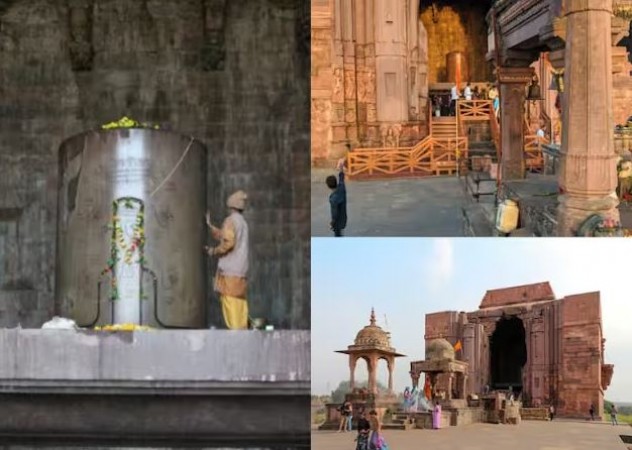
Perched atop the hills of Bhojpur, there lies a magnificent, albeit unfinished, Shiva temple known as Bhojeshwar Mandir or Bhojpur Shiv Mandir. This ancient temple, built by the renowned king Bhoj of the Parmar dynasty during his reign from 1010 AD to 1055 AD, is a testament to the architectural brilliance and devotion of a bygone era. The temple, set upon a platform measuring 115 feet (35 m) in length, 82 feet (25 m) in width, and 13 feet (4 m) in height, is renowned for its extraordinary feature—a colossal Shivling. Carved out of a single stone and made of smooth red sandstone, this Shivling is considered the largest ancient Shivling in the world, earning the Bhojeshwar temple the epithet "Somnath of North India."
The Grandeur of the Shivling
The centerpiece of the Bhojeshwar Temple is undoubtedly the colossal Shivling. Its sheer size and unique craftsmanship make it an awe-inspiring sight. Carved out of a single piece of smooth red sandstone, this ancient Shivling stands as a remarkable feat of architectural precision. With its imposing presence and intricate detailing, it captivates the imagination of devotees and visitors alike. The size and scale of the Shivling have earned the Bhojeshwar Temple a well-deserved reputation as one of the most significant Shiva shrines in the country.
The Unfinished Marvel
While the Bhojeshwar Temple stands as a testament to the grand vision of King Bhoj, it remains incomplete to this day. Despite its unfinished state, the temple's colossal proportions and the majesty of its Shivling continue to inspire wonder. The reasons behind the temple's incomplete status remain shrouded in mystery, leaving room for speculation and imagination. Nonetheless, the temple's unfinished state adds to its allure and highlights the ambition and devotion that went into its construction.
Architectural Brilliance
The Bhojeshwar Temple showcases the architectural brilliance of the Parmar dynasty. The temple's design features intricate carvings, pillars, and ornate motifs that exhibit the artistic finesse of the craftsmen of that era. The red sandstone used in its construction further enhances its visual appeal. The temple's architecture seamlessly blends intricate details with a sense of grandeur, creating a mesmerizing ambiance that transports visitors to a bygone era of architectural marvels.
Cultural and Historical Significance
The Bhojeshwar Temple holds immense cultural and historical significance in the region. It stands as a testament to the rich cultural heritage of India and serves as a link to its glorious past. The temple's association with King Bhoj adds an additional layer of historical importance, as it represents his patronage of art, architecture, and religious devotion. The Bhojeshwar Temple continues to be a site of pilgrimage and reverence for devotees of Lord Shiva, who seek blessings and spiritual solace within its sacred precincts.
Preservation and Restoration Efforts
Efforts are underway to preserve and restore the Bhojeshwar Temple, ensuring its legacy for future generations. Various organizations and authorities are actively involved in the conservation of this architectural gem. Restoration projects aim to maintain the structural integrity of the temple, safeguard its intricate carvings, and protect its historical value. Through these endeavors, the temple's grandeur and spiritual significance will continue to be celebrated for years to come.
The Bhojeshwar Temple, nestled in the hills of Bhojpur, stands as a testament to the devotion, artistic brilliance, and architectural prowess of ancient India. Its colossal Shivling, carved out of a single stone, is a marvel that beckons visitors from far and wide. Despite its incomplete state, the temple's grandeur and historical significance endure. As we admire its magnificence, we are transported to an era of unmatched craftsmanship and unwavering devotion. The Bhojeshwar Temple stands as a sacred abode of Lord Shiva, inviting seekers of spirituality to experience the divine presence in its hallowed halls.
Sawan Adhika Maas Starts on July 18, 2023
The Moche Civilization: Unveiling Peru's Intricate Pottery and Art
Why should non-vegetarian food should not be eaten in the month of Sawan?